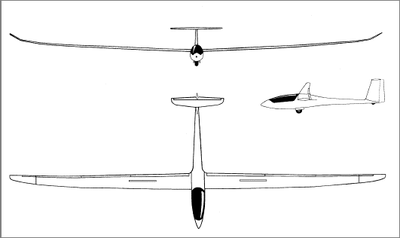Tue, Mar 08, 2022
AD 2022-05-05 Requires Inspecting The Affected Parts Of The Flaperon Control In The Wings...
The FAA is adopting a new airworthiness directive (AD) for all Schempp-Hirth Flugzeugbau GmbH Model Ventus-2a and Ventus-2b gliders.

This AD was prompted by mandatory continuing airworthiness information (MCAI) originated by an aviation authority of another country to identify and correct an unsafe condition on an aviation product. The MCAI describes the unsafe condition as severe corrosion on the inboard flaperon actuation push rods and ball bearing connecting the flaperon push rod to the bell crank inside the wing. This AD requires inspecting the affected parts of the flaperon control in the wings and taking corrective actions if necessary. The FAA is issuing this AD to address the unsafe condition on these products. This AD is effective April 11, 2022.
Supplementary Information: The FAA issued a notice of proposed rulemaking (NPRM) to amend 14 CFR part 39 by adding an AD that would apply to all Schempp-Hirth Flugzeugbau GmbH Model Ventus-2a and Ventus-2b gliders. The NPRM published in the Federal Register on December 6, 2021 (86 FR 68937). The NPRM was prompted by MCAI originated by the European Union Aviation Safety Agency (EASA), which is the Technical Agent for the Member States of the European Union. EASA issued AD 2020-0063, dated March 18, 2020 (referred to after this as “the MCAI”), to address an unsafe condition on Schempp-Hirth Flugzeugbau GmbH Models Ventus-2a, Ventus-2b, Ventus-2c, Ventus-2cM, and Ventus-2cT gliders.
The MCAI states:
- Severe corrosion has been found on the inboard flaperon actuation push rod of some sailplanes. Subsequent investigation determined that, when water ballast is dumped in flight, some water may be sucked into the wing upper side and enter the wing via the flaperon push rod. Intruding water may cause corrosion especially on the ball bearing connecting the flaperon push rod to the bell crank inside the wing.
- This condition, if not detected an[d] corrected, could lead to hard steering (when the ball bearing is damaged) or increased play (when the ball bearing has failed), possibly resulting in reduced control of the (powered) sailplane.
- To address this potential unsafe condition, Schempp-Hirth Flugzeugbau GmbH issued the [technical note] TN to provide inspection and replacement instructions.
- For the reason described above, this [EASA] AD requires repetitive inspections of the affected parts, as identified in the TN, and, depending on findings, replacement with serviceable parts.
You may examine the MCAI in the AD docket at https://www.regulations.gov by searching for and locating Docket No. FAA-2021-1019.
In the NPRM, the FAA proposed to require compliance with the version of the TN (revision 2) identified in the MCAI. The FAA is issuing this AD to address the unsafe condition on these products.
More News
Also: ANOTHER Illegal Drone, KidVenture Educational Activities, Record Launches, TSA v Shoes The Senate confirmed Bryan Bedford to become the next Administrator of the FAA, in a ne>[...]
Also: Sully v Bedford, Embraer Scholarships, NORAD Intercepts 11, GAMA Thankful Middle Georgia State University will be joining the Federal Aviation Administration’s fight ag>[...]
Also: DarkAero Update, Electric Aircraft Symposium, Updated Instructor Guide, OSH Homebuilts Celebrate The long-awaited Sonex High Wing prototype has flown... the Sonex gang tells >[...]
Also: Sully v Bedford, Embraer Scholarships, NORAD Intercepts 11, GAMA Thankful Middle Georgia State University will be joining the Federal Aviation Administration’s fight ag>[...]
30-Year USCG Veteran Aviator Focusing On Member Benefits The Vertical Aviation International Board of Directors announced its new leadership officers in April, and all began their >[...]
 Airborne 07.11.25: New FAA Boss, New NASA Boss (Kinda), WB57s Over TX
Airborne 07.11.25: New FAA Boss, New NASA Boss (Kinda), WB57s Over TX Airborne-Flight Training 07.10.25: ATC School, Air Race Classic, Samson School
Airborne-Flight Training 07.10.25: ATC School, Air Race Classic, Samson School Airborne Affordable Flyers 07.03.25: Sonex HW, BlackShape Gabriel, PRA Fly-In 25
Airborne Affordable Flyers 07.03.25: Sonex HW, BlackShape Gabriel, PRA Fly-In 25 Airborne-Flight Training 07.10.25: ATC School, Air Race Classic, Samson School
Airborne-Flight Training 07.10.25: ATC School, Air Race Classic, Samson School Rick Kenin New Board Chair of VAI
Rick Kenin New Board Chair of VAI



